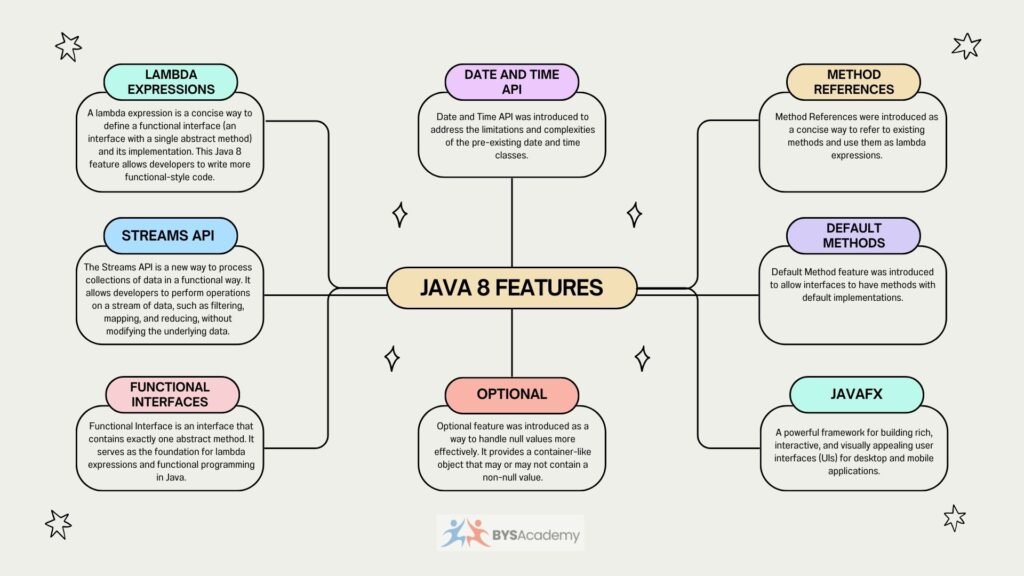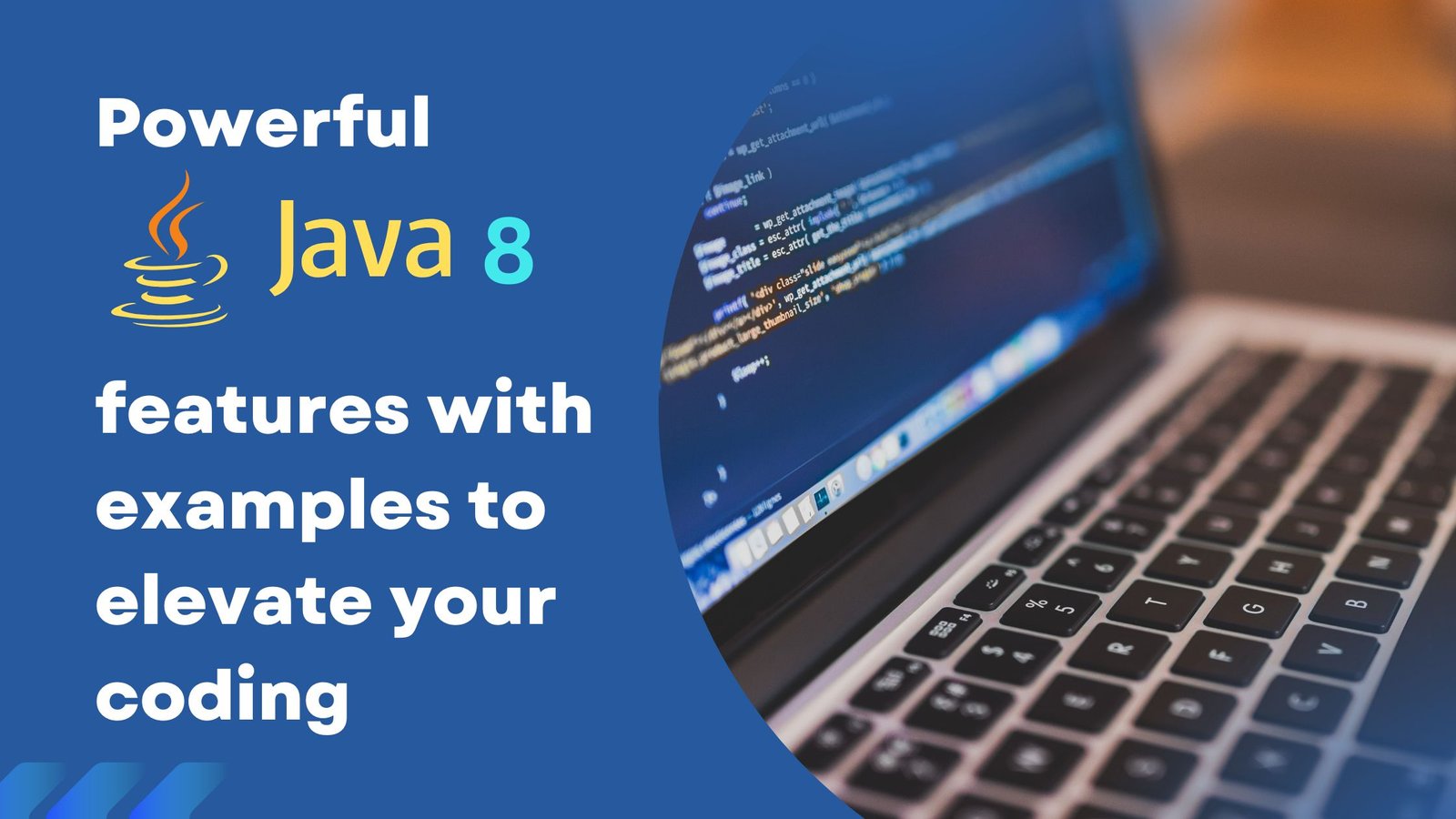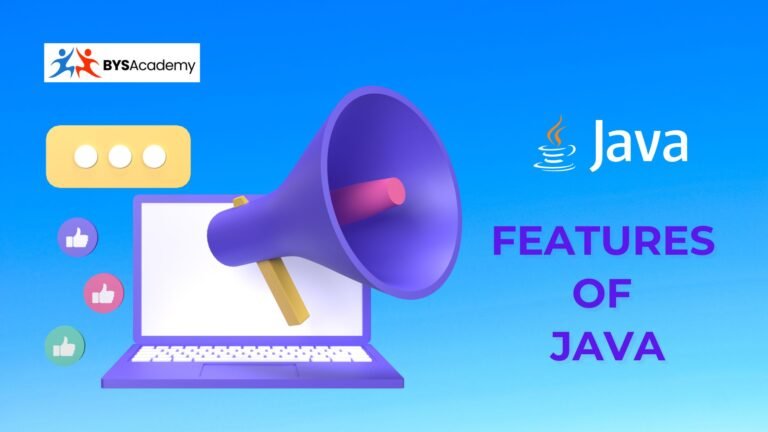TL;DR: Java 8 revolutionized Java programming with powerful features like Lambda Expressions for cleaner code, Streams API for efficient data processing, Optional to handle null safely, Functional Interfaces to enable functional programming, Default Methods for backward compatibility in interfaces, and Method References for concise method invocation. Additionally, the Date-Time API replaced the old Date class with more robust handling, while JavaFX became the modern UI toolkit. These enhancements collectively make Java code more expressive, readable, and efficient.
Java 8 Introduction
Welcome to the world of Java 8 Features! With its powerful enhancements, Java 8 introduces lambdas and functional programming, revolutionizing code readability and efficiency. The Stream API enables streamlined data processing, while the Optional class enhances null value handling. Core libraries are enriched, and the java.time package provides improved date and time functionality. Java 8 brings numerous language improvements for a more enjoyable development experience.
Whether you’re an experienced Java developer or just starting, Java 8 features opens up exciting possibilities for writing expressive and concise code. Let’s embark on this journey into the realm of Java 8 Features with examples together!

List of Java 8 Features With Examples
1. Lambda Expressions
A lambda expression is a concise way to define a functional interface (an interface with a single abstract method) and its implementation. This Java 8 feature allows developers to write more functional-style code, and it is a key feature for functional programming in Java.
Here is an example of a lambda expression that defines a function that takes in two integers and returns their sum:
((int x, int y) -> x + y);In this example, the lambda expression defines a function that takes in two integers (x and y) and returns their sum (x + y). The syntax of a lambda expression is as follows:
(parameters) -> expressionThe parameters are the input values that are passed to the lambda expression. The expression is the code that is executed when the lambda expression is called.
Here is an example of how the above lambda expression could be used to add two numbers:
interface Calculator {
int calculate(int x, int y);
}
Calculator add = (int x, int y) -> x + y;
int result = add.calculate(5, 3);
System.out.println(result); // 8In this example, we first define an interface Calculator with a single abstract method calculate. Then, we create an instance of the Calculator interface, add, and assign it the lambda expression (int x, int y) -> x + y which implements the calculate() method of the interface. Finally, we call the calculate() method on the add object and pass in two integers, 5 and 3.
The lambda expression is one of the concise and powerful Java 8 features, and it allows developers to write functional-style code that is more expressive, readable, and maintainable.
2. Streams API
The Streams API is a new way to process collections of data in a functional way. It allows developers to perform operations on a stream of data, such as filtering, mapping, and reducing, without modifying the underlying data.
Here is an example of how the Streams API could be used to filter a list of integers and then find the first even number:
List<Integer> numbers = Arrays.asList(1, 2, 3, 4, 5, 6, 7, 8, 9, 10);
Optional<Integer> firstEven = numbers.stream()
.filter(n -> n % 2 == 0)
.findFirst();
System.out.println(firstEven.get()); // 2In this example, we first create a list of integers numbers. Then, we use the stream() method to create a stream of the integers in the list. We then use the filter() method to filter the stream to only include even numbers. Finally, we use the findFirst() method to find the first even number in the stream. Learn Streams API through examples to gain deeper understanding and become proficient in programming with Java 8.
The Streams API provides several operations that can be chained together to create a pipeline of data processing. These operations include:
- filter(): which allows you to filter elements based on a certain condition
- map(): which allows you to transform elements in the stream into new elements
- reduce(): which allows you to perform a reduction operation on the elements in the stream
- sorted(): which allows you to sort the elements in the stream
- count(): which allows you to count the number of elements in the stream
It’s worth noting that the Streams API is lazy, meaning that it only performs the operations that are needed to produce the final result. This makes the Streams API more efficient and can lead to better performance for large data sets.
Streams are also designed to be parallelizable, meaning that the operations can be performed in parallel across multiple cores, which can lead to significant performance improvements for large data sets on multi-core systems.
In conclusion, the Streams API provides a powerful and expressive way to process collections of data in a functional way, making it easier to write expressive, readable, and maintainable code.
3. Functional Interfaces
In Java 8, a Functional Interface is an interface that contains exactly one abstract method. It serves as the foundation for lambda expressions and functional programming in Java. The presence of a single abstract method allows Functional Interfaces to be used as targets for lambda expressions, providing a concise and expressive way of defining behavior.
For example, consider the java.util.function.Predicate interface. It is a Functional Interface with a single abstract method called test(), which takes an argument and returns a boolean value. With a Predicate, you can define a condition or rule that can be evaluated against a given value.
Here’s an illustration of using Predicate with a lambda expression:
Predicate<Integer> isEven = (number) -> number % 2 == 0;
boolean result = isEven.test(6); // Evaluates whether 6 is even
System.out.println(result); // Output: trueIn this example, we define a Predicate called isEven that checks whether a given number is even. The lambda expression (number) -> number % 2 == 0 represents the implementation of the test() method. We then use isEven.test(6) to evaluate whether 6 is even, and the result is true.
Functional Interfaces provide a powerful way to encapsulate behavior and pass it around as a method parameter or return value. They enable more concise and readable code, promoting a functional programming style in Java 8 and beyond.
4. Date and Time API
In Java 8, the Date and Time API was introduced to address the limitations and complexities of the pre-existing date and time classes. This new API provides a more intuitive and powerful way to work with dates, times, durations, and intervals.
The Date and Time API introduces a set of classes under the java.time package, such as LocalDate, LocalTime, LocalDateTime, and Duration. These classes offer improved immutability, clarity, and consistency in representing date and time values.
Here’s an example to showcase the usage of the Date and Time API:
LocalDateTime now = LocalDateTime.now(); // Get the current date and time
LocalDate date = now.toLocalDate(); // Extract the date from the current date and time
LocalTime time = now.toLocalTime(); // Extract the time from the current date and time
System.out.println("Current Date: " + date);
System.out.println("Current Time: " + time);In this example, we create a LocalDateTime object using the now() method, which represents the current date and time. We then extract the date and time components separately using the toLocalDate() and toLocalTime() methods. Finally, we print out the current date and time components.
The Date and Time API in Java 8 simplifies working with dates and times, provides better consistency across different operations, and offers enhanced functionality for performing calculations and manipulations. It greatly improves the overall experience of handling date and time-related operations in Java.
5. Optional
In Java 8, the Optional feature was introduced as a way to handle null values more effectively. It provides a container-like object that may or may not contain a non-null value. With Optional, you can avoid the common pitfalls and risks associated with null pointer exceptions.
The main advantage of Optional is that it encourages a more explicit and safer way of handling potential null values. Instead of directly accessing a potentially null reference, you can use methods provided by Optional to perform operations on the value, or handle the absence of a value gracefully.
Here’s an example to illustrate the usage of Optional:
Optional<String> optionalName = Optional.ofNullable(getName());
String name = optionalName.orElse("Unknown");
System.out.println("Name: " + name);In this example, we use Optional to handle the value returned by the getName() method, which may be null. By using Optional.ofNullable(), we wrap the value in an Optional object. Then, we use the orElse() method to specify a default value (“Unknown”) to be used if the optional value is null. Finally, we print the name, ensuring that it will always have a non-null value.
Optional provides methods like isPresent(), get(), orElse(), and many more to work with potentially nullable values in a more expressive and safe manner. It encourages explicit handling of null scenarios and helps to write more robust and readable code.
6. Method References
In Java 8, Method References were introduced as a concise way to refer to existing methods and use them as lambda expressions. It allows you to treat a method as a first-class object, simplifying the code and making it more readable.
Method References can be thought of as shortcuts for writing lambda expressions when the implementation of the lambda expression is already defined in an existing method. They provide a way to reuse existing code and promote code reusability.
Here’s an example to illustrate the usage of Method References:
List<String> names = Arrays.asList("Alice", "Bob", "Charlie");
// Using lambda expression
names.forEach(name -> System.out.println(name));
// Using method reference
names.forEach(System.out::println);In this example, we have a list of names and we want to print each name using the System.out.println() method. In the first approach using a lambda expression, we explicitly define the lambda expression to print each name. In the second approach using a method reference, we simply refer to the println method of System.out directly.
Method References provide a more concise and expressive way to refer to existing methods, making the code more readable and maintaining code consistency. They are particularly useful when working with functional interfaces and provide an elegant way to reuse existing method implementations.
7. Default Methods
In Java 8, the Default Method feature was introduced to allow interfaces to have methods with default implementations. This feature was added to provide backward compatibility for existing interfaces when new methods were added.
With Default Methods, interfaces can define method implementations that are automatically available to all implementing classes. This allows interfaces to evolve by adding new methods without breaking the existing implementations.
Here’s an example to illustrate the usage of Default Methods:
interface Vehicle {
void start();
default void stop() {
System.out.println("Vehicle stopped.");
}
}
class Car implements Vehicle {
@Override
public void start() {
System.out.println("Car started.");
}
}
public class Main {
public static void main(String[] args) {
Car car = new Car();
car.start();
car.stop();
}
}
// Using method reference
names.forEach(System.out::println);In this example, we have an interface Vehicle with two methods: start() and a default method stop(). The start() method is implemented in the Car class, while the stop() method has a default implementation in the Vehicle interface.
When we create an instance of the Car class and invoke the start() and stop() methods, we see the corresponding messages printed to the console.
Default Methods allow interfaces to provide a default behavior for methods, reducing the need to modify all implementing classes when new methods are added to an interface. They enable incremental evolution of interfaces and enhance code reusability in Java 8 and beyond.
8. JavaFX
In Java 8, JavaFX was introduced as a powerful framework for building rich, interactive, and visually appealing user interfaces (UIs) for desktop and mobile applications. It provides a set of libraries and APIs that make it easier to create modern UIs with a wide range of graphical components and visual effects.
JavaFX offers a declarative approach to UI development, allowing developers to define UI elements using FXML or programmatically using Java code. It provides a comprehensive set of UI controls, layout managers, and styling options, giving developers the flexibility to design UIs that meet their specific needs.
Here’s a simple example that demonstrates the usage of JavaFX:
import javafx.application.Application;
import javafx.scene.Scene;
import javafx.scene.control.Button;
import javafx.scene.layout.StackPane;
import javafx.stage.Stage;
public class Main extends Application {
public static void main(String[] args) {
launch(args);
}
@Override
public void start(Stage primaryStage) {
Button button = new Button("Click Me!");
button.setOnAction(event -> System.out.println("Button clicked!"));
StackPane root = new StackPane();
root.getChildren().add(button);
Scene scene = new Scene(root, 300, 200);
primaryStage.setTitle("JavaFX Application");
primaryStage.setScene(scene);
primaryStage.show();
}
}In this example, we create a simple JavaFX application with a button that prints a message to the console when clicked. We use various JavaFX classes, such as Button, StackPane, and Scene, to define the UI components and their layout. The start() method is the entry point of the JavaFX application, where we set up the UI components and create the main application window.
JavaFX provides a wide range of features, including multimedia support, 2D and 3D graphics, animation, and event handling. It offers a modern and intuitive way to create visually appealing and interactive UIs in Java applications, making it a valuable addition to the Java platform in Java 8.
Conclusion
In conclusion, Java 8 brings a plethora of powerful features and enhancements that greatly improve the programming experience. With the introduction of lambdas, functional programming constructs, the Stream API, and the Optional class, developers can write more concise, expressive, and robust code. The Date and Time API simplifies working with dates and times, while Method References and Default Methods enhance code readability and reusability.
Additionally, JavaFX provides a rich framework for building modern user interfaces. Java 8 features opens up exciting possibilities for developers, empowering them to create more efficient, maintainable, and innovative applications. Embracing Java 8 features unlocks the full potential of the Java programming language and paves the way for modern Java development.
Practice Quiz

Enjoyed this article? Share it with your network and help others build the right skills! 👉 Click an icon below to share.
Your support helps us create more valuable content. Thank you! ❤️
Published on January 24, 2023
Last updated on December 31, 2024



